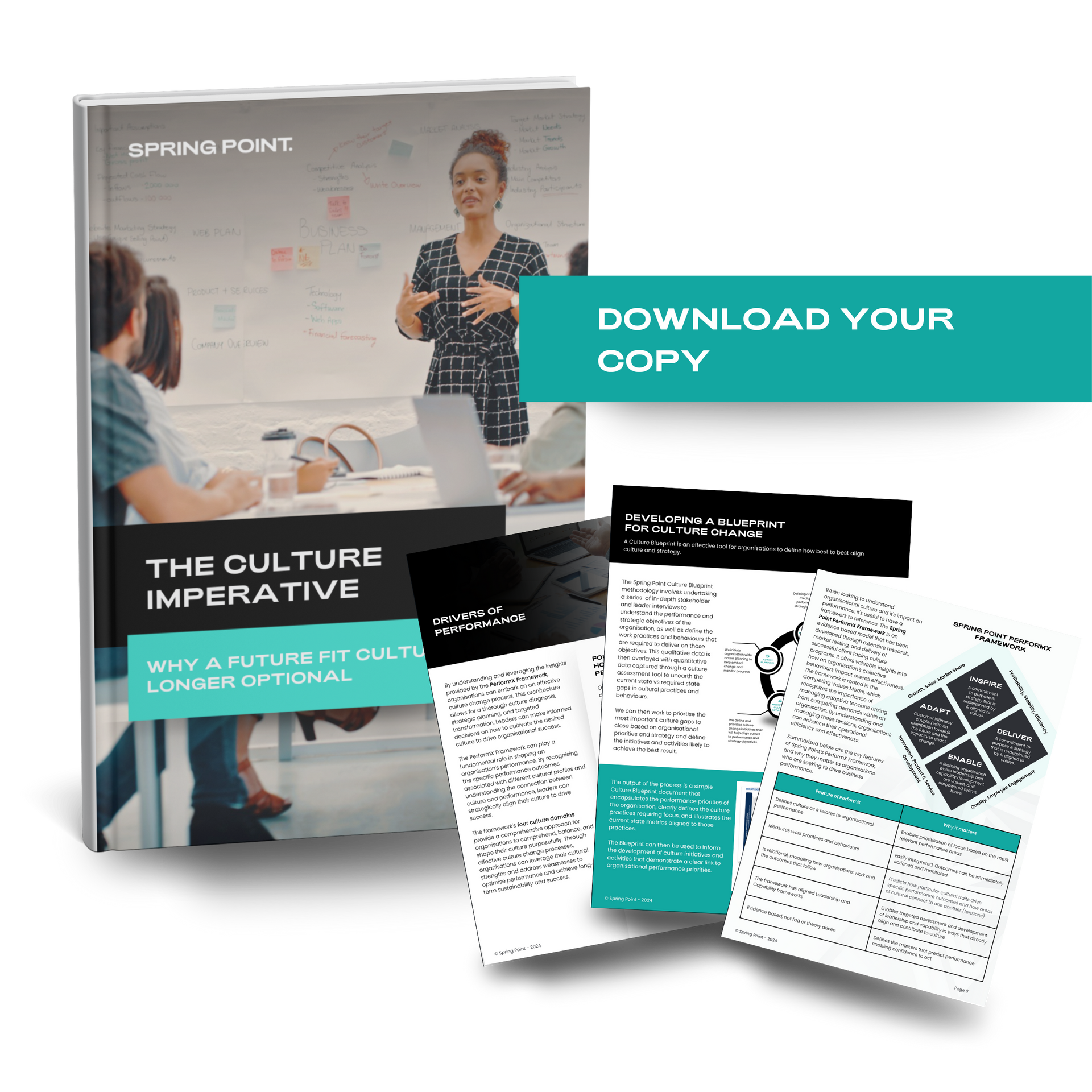WHITE PAPER
THE CULTURE IMPERATIVE
WHY A FUTURE FIT CULTURE IS NO LONGER OPTIONAL
Spring Point have been partnering with Australian organisations for the past 10 years, helping them develop healthy, adaptive cultures that deliver on performance, build organisational resilience, and enable business strategy. We work with oganisations to ensure culture investment is prioiritised as a key driver of business performance, and not merely seen as 'the vibe' or about ‘how employees get along'.
Our latest white paper explores what a 'FUTURE FIT' culture looks like, how organisations can practically go about defining their current and aspired culture, and how to demonstrate the links between culture, strategy and performance when it comes to creating a business case for change.
"FOR THE TIMES, THEY ARE A-CHANGIN' "
-Bob Dylan
The future of work; a much-used phrase to provoke thoughts about 'workplaces that one day, could be' is now here. Arriving at the exact same time however is a global context of volatility and uncertainty of magnitude not experienced since post World War II.
The immediate implications of these changes for organisations are both ambiguous yet at the same time, remarkably clear. Now's the time for quickly recognising that the world of work we have been in for the past three decades is changing rapidly, meaning it's time to quickly digest and begin creating a future fit organisation.
WHY FUTURE FIT, ADAPTIVE CULTURES ARE
MORE IMPORTANT THAN EVER
GENERATIVE AI
How we work, the role of AI, and what it means for culture, people and organisational capaility are all topics that organisations are grappling with right now.
GENERATIONAL DIFFERENCES
How we work, what we value and what 'purpose' means differs across our workforce generations, and its impacting culture now.
HYBRID NORMS
Changes to where and how we work, and the ongoing return to the office conundrum feel unresolved for may organisations.
GEOPOLITICAL INSTABILITY
The world we are living and working in has changed significantly on the past couple of years, meaning that organisational change is inevitable.
WHAT DOES A FUTURE FIT
CULTURE LOOK LIKE?
Common features of a 'future fit' culture include ways of working that are learning oriented, inclusive, results-driven, customer-centric, and collaborative, amongst other traits.
On the other hand, change-averse cultures are characterised by attributes such as excessive hierarchy, process excellence that extends to rigidity, siloed work practices and a lack of experimentation.
The performance difference between the organisations who have adaptive cultures and those that don’t is not only significant [5] but it is growing exponentially.
ORGANISATIONS WITH FUTURE FIT, HEALTHY CULTURES....
9x
reported excellent (71-100 eNPS scores) 9x more often than their 'unfit' counterparts.
4.5x
are 4.5x more likely to report an increase in employee engagement scores since the onset of the pandemic
4x
are 4x more likely to have experienced an improvement in employee retention.
START YOUR JOURNEY TOWARDS A 'FUTURE FIT' CULTURE
ORGANISATIONAL CULTURE ARTICLES
HOW WE CAN HELP
We support the Board, CEO, Senior Executives and front-line teams to define the organisational culture needed to enable strategy, and to activate the changes necessary to generate alignment, performance and great places to work.












